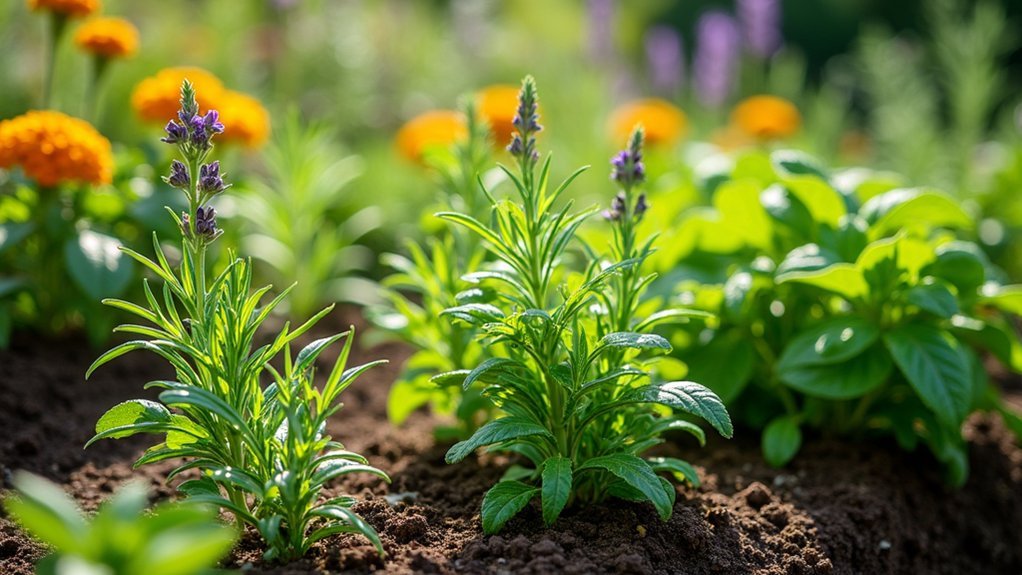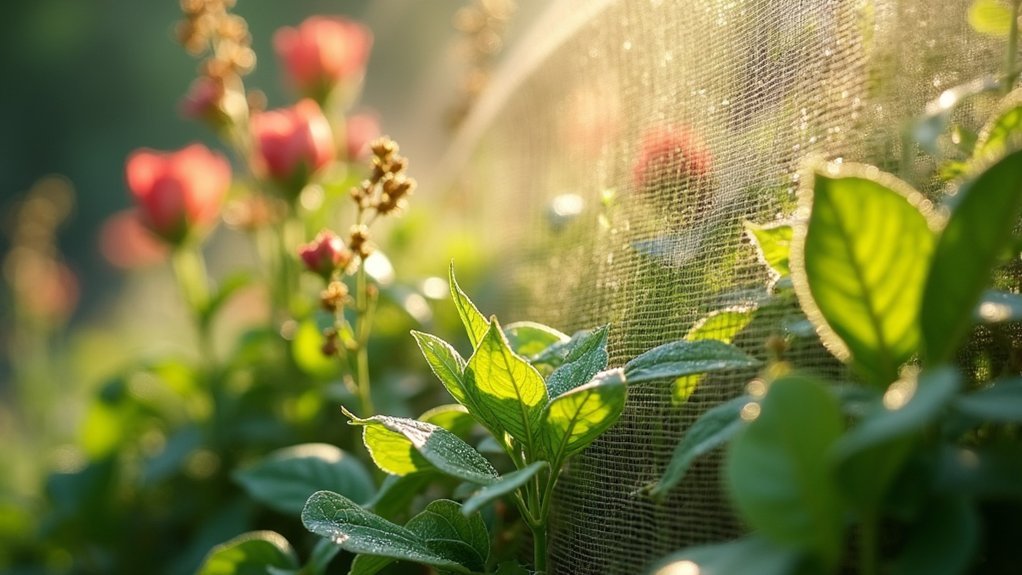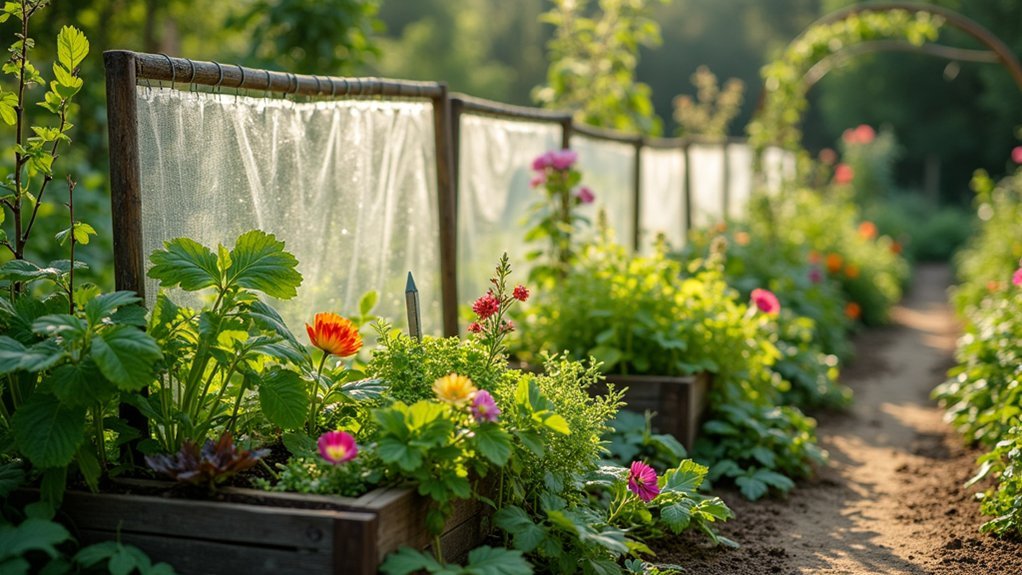Seasonal living barriers offer natural pest protection year-round. In spring, establish thorny shrubs like buckthorn at property edges. Summer calls for herb barriers—marigolds, basil, and dill repel specific pests while protecting vegetables. Fall is ideal for creating dense, rodent-resistant hedges with roses and blackthorns. Winter-hardy plants like arborvitae provide continuous protection even in cold months. Enhance these defenses with copper barriers and essential oils for a complete, chemical-free shield against unwanted visitors.
Spring Defensive Planting: Creating Your First Line of Defense

When spring arrives with its warming soil and gentle rains, it presents the perfect opportunity to establish your property’s natural pest defense system. This season offers ideal conditions for root development before peak pest activity begins.
Select hardy defensive shrubs like buckthorn, Osage orange, and thorny rose species to create effective barriers. Plant larger, spiky species at property edges with smaller, dense shrubs in front to maintain visibility while deterring pests. Focus on vulnerable corners and entry points to strengthen overall security.
Ensure proper planting depth and width for maximum root expansion, and loosen root balls before installation. Add mulch around new plantings to retain moisture and discourage weeds that harbor pests.
For warmer zones, consider barrel cacti for year-round protection that requires minimal maintenance. Strategic placement of thorny climbing plants like Pyracantha can provide additional security by discouraging fence scaling while adding vibrant berries for visual interest.
Essential Oils as Seasonal Perimeter Guards
Beyond physical barriers, nature offers aromatic solutions that act as invisible shields against unwelcome visitors. You’ll find essential oils provide targeted protection throughout the year when strategically deployed around your home’s perimeter. Tea tree oil can effectively eliminate fleas and ticks from your home environment due to its potent antiparasitic properties.
| Season | Primary Oil | Target Pests |
|---|---|---|
| Spring | Lavender | Fleas, Ticks |
| Summer | Citronella | Mosquitoes |
| Fall | Peppermint | Rodents, Spiders |
| Winter | Eucalyptus | General insects |
Rotate your defenses by diffusing oils during peak pest activity at dawn and dusk. For outdoor protection, mix oils with water and alcohol in spray bottles, concentrating on entry points. You’ll maximize effectiveness by increasing concentrations during heavy infestations and pairing with pest-resistant herbs for layered protection. Reapply every 7-10 days for continuous defense without harmful chemicals.
Summer-Ready Herb Barriers That Repel Multiple Pests

Garden defenders await in your summer herb selection, offering both culinary benefits and natural pest protection.
Plant dill in well-draining soil to repel aphids and spider mites, or pair it with nasturtiums for enhanced protection against squash bugs.
Dill thrives in well-drained conditions, creating a natural barrier against common garden pests while complementing nasturtiums for superior squash protection.
Marigolds thrive in full sun and create excellent barriers around tomatoes and peppers, deterring both nematodes and aphids.
For mosquito defense, incorporate basil and catnip—both require fertile soil but offer impressive versatility. Basil partners beautifully with tomatoes, while catnip (zones 3-9) provides protection for squash plants. Consider supplementing your herb barriers with garden fabric that screens out insects while still allowing light and water to reach your plants.
Don’t overlook chives, which flourish in partial shade and deter slugs while improving soil health around roses.
Most of these defensive herbs adapt to various hardiness zones, making them practical additions to any summer garden’s pest management strategy.
Crafting Natural Copper Barriers for Plant Protection
While herbs offer botanical protection against many pests, copper barriers represent a physical solution that’s particularly effective against slugs and snails.
Copper creates an electrochemical reaction with mollusk mucus, deterring them without toxic chemicals or harm to beneficial garden organisms.
You’ll find multiple application methods to suit your garden’s specific needs:
- Wrap adhesive copper tape (minimum 1-inch width) around pots and raised beds, ensuring no gaps
- Create custom rings from recycled copper pipe for protecting individual plants
- Install copper mesh screens around vulnerable shrub stems and seedlings
- Use double-layer wrapping for intensive protection in heavily infested areas
- Secure copper to table legs to elevate container plants beyond pest reach
The initial investment pays dividends through copper’s 5+ year lifespan and minimal maintenance requirements—oxidation won’t reduce effectiveness. Products like Gonzo Copper Stopper offer a ready-to-use option with 30 feet of tape that creates an effective barrier against garden gastropods.
Fall Preparedness: Rodent-Resistant Living Fences

As autumn leaves begin to fall, implementing rodent-resistant living fences becomes a strategic move for long-term garden protection.
You’ll find thorny plants like roses and blackthorns particularly effective at deterring climbing rodents, while dense planting minimizes entry gaps.
Enhance your living fence’s effectiveness by allowing natural thicket formation and incorporating deep-rooted species that prevent burrowing.
For maximum protection, consider a layered approach—combine your living fence with wire mesh barriers, especially at the base.
Choose plants with coppicing ability and drought tolerance for a resilient barrier that serves multiple purposes.
Beyond pest control, you’ll enjoy soil conservation benefits, wind protection, and seasonal beauty with vibrant fall foliage.
With proper maintenance, your living fence will provide centuries of protection while supporting local biodiversity.
Historical examples like George Washington’s use of honey locust demonstrate the long-standing recognition of living fences as effective barriers against unwanted animals.
Seasonal Moisture Management Through Strategic Landscaping
Proper moisture management throughout the changing seasons requires thoughtful landscape design that works with, rather than against, nature’s cycles.
Working with nature’s rhythms creates resilient landscapes that thrive through every season’s moisture challenges.
You’ll find that strategic plant placement and smart irrigation practices can dramatically reduce water usage while maintaining a vibrant landscape.
- Create microclimates by placing tall shrubs to provide shade, reducing evaporation in vulnerable areas.
- Install zone-specific irrigation systems that deliver precise amounts of water based on soil type and plant needs.
- Apply organic mulch at 2-3 inch depths to retain moisture and regulate soil temperature year-round.
- Encourage deep root growth through infrequent but thorough watering sessions.
- Incorporate drought-resistant plants in areas that naturally receive less moisture.
Modern weather apps can provide detailed rainfall predictions to help you plan irrigation schedules and avoid overwatering during seasons with adequate natural precipitation, ultimately creating smart maintenance calendars for your landscape.
Insect Mesh Integration With Ornamental Plants

Integrating protective mesh barriers into your ornamental garden offers a natural defense against destructive pests without compromising aesthetic appeal.
Select UV-stabilized polypropylene or polyester meshes that balance airflow with protection—finer meshes for smaller pests like aphids and whiteflies.
You’ll find installation relatively straightforward: drape mesh over hoops or frames around prized specimens or entire beds. Trim precisely to fit irregular spaces. This physical barrier considerably reduces your need for chemical interventions while supporting IPM strategies.
Consider potential microclimate effects when implementing mesh in your garden. The material may slightly alter temperature and airflow, so monitor your plants’ responses. The reusable nature of quality insect netting justifies the initial investment as it can last for multiple growing seasons.
During peak pest seasons, you can temporarily deploy mesh and combine it with sticky traps for extensive protection, making sustainable gardening more achievable.
Winter-Hardy Barrier Plants That Work Year-Round
Your yard’s first line of defense doesn’t need to hibernate when temperatures drop.
You’ll find evergreen repellents like tansy and rosemary maintain their pest-deterring properties throughout winter while adding aromatic benefits to your landscape.
Cold-resistant protective hedges such as arborvitae and boxwood create impenetrable barriers that shield your property from both unwanted critters and harsh winter winds.
For maximum protection against browsing deer and other herbivores, consider incorporating thorny plants like winged thorn roses or jujubes at the perimeter of your garden.
Evergreen Repellent Varieties
While many gardeners focus on seasonal pest control, winter-hardy evergreen plants offer a year-round natural defense system against unwanted visitors.
These resilient varieties maintain dense foliage throughout winter, creating physical barriers that deter pests from entering your garden and home. The integration of these plants represents an effective approach to integrated pest management that can lead to healthier plants and reduced insecticide costs.
- Boxwood (Buxus spp.) features waxy leaves that discourage insects and creates impenetrable hedges.
- Holly (Ilex spp.) combines protective foliage with insect-deterring properties and winter hardiness.
- Yew (Taxus spp.) produces natural compounds that repel certain pests while providing dense coverage.
- Pine and cedar varieties emit natural scents that keep many insects and small mammals at bay.
- Strategic evergreen hedges disrupt pest lifecycles by limiting overwintering sites and travel routes.
These plants not only beautify your landscape but create microclimates that naturally suppress pest populations year-round.
Cold-Resistant Protective Hedges
Cold-resistant protective hedges serve as nature’s living fences, providing year-round barriers against pests while withstanding harsh winter conditions. American Arborvitae and Boxwood ‘Green Mountain’ offer dense foliage that prevents pest migration even during winter months. The Emerald Green Arborvitae requires only a light trim every few years due to its slow, upright growth habit. You’ll find these natural shields require minimal maintenance once established.
| Hedge Type | Key Benefits |
|---|---|
| American Arborvitae | Fast growth, native to North America |
| Boxwood ‘Green Mountain’ | Evergreen, suitable for zones 5-8 |
| Pittosporum ‘Silver Sheen’ | Frost-resistant with silvery leaves |
| Photinia robusta | Robust nature in cold conditions |
| Escallonia iveyii | White summer flowers, cold-tolerant |
Prepare well-draining soil when planting and implement regular pruning to maintain density. These hedges not only deter pests but also support local biodiversity and contribute to carbon sequestration—making them environmentally beneficial choices for your landscape.
Combining Traps With Living Barriers for Maximum Effect

When strategic pest management is your goal, combining traps with living barriers creates a powerful defense system that far exceeds using either method alone.
By positioning traps near vulnerable entry points in your living barrier network, you’ll intercept pests that might otherwise find their way through gaps. Understanding pest route identification allows for more effective trap placement and significantly increases capture rates.
- Place pheromone traps during spring planting to prevent early-season pest establishment
- Deploy sticky traps near flowering barriers to capture aphids without harming beneficial pollinators
- Check traps weekly to identify barrier weaknesses and adjust planting density accordingly
- Integrate rodent traps along dense hedge lines in fall when pests seek winter shelter
- Rotate trap types seasonally to adapt to changing pest lifecycles and maximize effectiveness
This integrated approach reduces chemical dependency while providing valuable monitoring data to continuously improve your defense strategy.
Marigold Corridors: Beautiful Boundaries Against Soil Pests
You’ll find marigolds offer more than just bright colors in your garden—they’re powerful warriors against soil pests, particularly nematodes that damage plant roots.
By creating corridors of these vibrant flowers around your vegetable beds or along garden pathways, you’re establishing natural barriers that repel harmful organisms while attracting beneficial insects.
These flowering boundaries work best when you strategically pair them with compatible plants like tomatoes, peppers, and cabbage, creating an extensive defense system that protects your garden while enhancing its beauty. The Piedmont Master Gardeners have shown consistent commitment to advancing such natural gardening techniques in communities.
Nematode-Fighting Flower Borders
Marigold borders provide a dual-purpose defense system, simultaneously beautifying garden edges while waging chemical warfare on destructive nematodes beneath the soil.
These flowering sentinels release alpha-terthienyl from their roots, a powerful compound that inhibits nematode egg development and starves existing populations.
For peak effectiveness when establishing your marigold defense:
- Choose proven varieties like Tagetes patula “Nematode Control Mix” rather than ornamental types that lack suppression properties
- Plant densely as borders around susceptible crops rather than interplanting
- Allow at least 2 months of growth before your main crop for sufficient root compound accumulation
- Confirm soil temperatures exceed 70°F (21°C) for ideal chemical production
- Consider pre-plant cover cropping for 3-4 months followed by tilling for persistent protection
While complete eradication isn’t possible, continuous use of marigolds in your garden rotation can help manage fourteen genera of plant-parasitic nematodes effectively.
Companion Planting Strategies
Create marigold corridors throughout your garden to establish beautiful yet functional boundaries against soil pests. These vibrant flowers naturally deter nematodes and other harmful organisms while adding visual appeal.
Position these corridors strategically to divide garden sections and maximize protection. Complement your marigold borders with trap crops like Blue Hubbard squash, planted early to lure pests away from main plantings.
Incorporate tall plants such as dill or corn as visual barriers that disrupt pest movement patterns. For thorough protection, surround vulnerable crops with strong-scented herbs like sage and thyme that confuse pests and prevent them from locating host plants. This approach supports a balanced environment that naturally reduces the need for chemical pesticides while promoting biodiversity.
Remember that garden layout is essential—arrange companion plants to create beneficial microclimates and guarantee they don’t compete for resources while collectively building soil health.
Adapting Your Living Barriers to Changing Pest Patterns
As seasons shift and weather patterns evolve, your living pest barriers require thoughtful adjustments to remain effective against changing pest behaviors.
Climate change has extended pest active seasons while extreme weather events displace pests into human environments, demanding flexible barrier strategies beyond traditional timing.
Today’s shifting climate demands adaptable pest protection that evolves with increasingly erratic pest behaviors and extended activity cycles.
- Reinforce barriers in early spring when pests emerge seeking warmth and food
- Intensify monitoring and maintenance during summer’s ideal breeding conditions
- Seal entry points before fall when rodents begin seeking indoor shelter
- Create 12-inch vegetation-free zones around structures during warmer months
- Adjust your inspection schedule to align with seasonal pest activity patterns
Smart technologies with environmental sensors can help monitor conditions that attract specific pests, allowing for more precise timing of barrier adjustments.
Remember that unpredictable seasonal shifts have undermined traditional pest calendars.
Native Plants as Sustainable Pest Barriers Through the Seasons
Native plants represent nature’s original pest management system, offering year-round protection that adapts automatically to seasonal challenges. Their evolved chemical defenses, like milkweed’s toxic sap and oak tannins, deter herbivores while supporting beneficial pollinators.
You’ll benefit from spring ephemerals emerging before pest populations peak, while summer bloomers produce protective compounds during high-activity months. By fall, tougher foliage and seeds resist migrating pests, and winter dormancy patterns synchronize with reduced pest pressure.
Beyond seasonal timing, natives create biodiversity that sustains predator species controlling up to 90% of pest populations. Their specialized root systems maintain soil microbiomes that suppress diseases, while native-specific mycorrhizae boost immunity against pathogens.
This creates a continuous, self-regulating defense system that strengthens with each passing season.
Frequently Asked Questions
How Long Do Living Barriers Take to Establish Effective Pest Protection?
Effective pest protection from living barriers varies. You’ll see initial protection in 2-3 months with fast-growing plants, but full effectiveness typically takes 1-2 years as plants mature and establish their natural deterrent properties.
Can Living Barriers Attract Beneficial Insects While Repelling Pests?
Yes, you’ll find living barriers can simultaneously attract beneficial insects while repelling pests. Plants like lavender deter unwanted visitors while their nectar-rich flowers invite pollinators and predatory insects that naturally control pest populations.
Are Natural Pest Barriers Safe for Households With Pets?
Yes, many natural pest barriers are pet-safe. You’ll find diatomaceous earth, cedar products, and physical exclusion methods offer effective protection without the risks chemical pesticides pose to your furry family members.
How Do Seasonal Barriers Affect Local Wildlife Ecosystems?
Your fences disrupt wildlife migrations, forcing animals to detour or get trapped. They’ll face reduced breeding, genetic diversity, and food access. Climate changes worsen these effects, threatening long-term ecosystem health and species survival.
What Maintenance Do Living Barriers Require During Extreme Weather Conditions?
You’ll need to inspect your living barriers after storms, clear debris promptly, reinforce anchoring, repair damage immediately, and apply protective coatings. Regular maintenance prevents structural failures when extreme weather tests their resilience.
In Summary
You’ll find living barriers transform your garden while eliminating harmful chemicals. As you’ve seen, these seasonal solutions work with nature’s rhythms to defend your space year-round. By integrating native plants, essential oils, and thoughtful design, you’re creating a resilient ecosystem that protects itself. Remember, your garden isn’t just surviving—it’s thriving through a balanced approach that welcomes beneficial creatures while deterring unwanted guests.





Leave a Reply